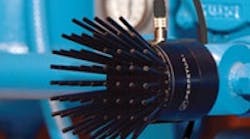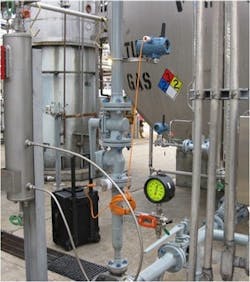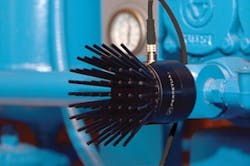Processors are showing increasing interest in installing wireless instruments. However, reliance on batteries and the cost of replacing them is causing some concerns. So, chemical makers should welcome rapidly emerging developments that enable vibrations or heat gradients to scavenge power that then can supplement or even supplant batteries. Already, a number of sites are pioneering use of such energy harvesting with wireless devices.
One of the most novel entrants into the market is the Intelligent Power Module (IPM) from Perpetuum, Southampton, U.K. (Figure 1). Jointly developed with Emerson Process Management, Austin, Tex., the IPM allows users to connect Perpetuum's vibration energy harvester to a Rosemount 3051S wireless pressure sensor — this delivers significant savings by avoiding the need to regularly replace batteries, even at fast update rates of a few seconds.
FOCUS ON INTERCHANGEABILITY
However, the thinking behind the IPM goes further than this. "The big news here is the complete and simple interchangeability of the IPM unit. Not only can you use it with vibration energy harvesters, but also thermal harvesters from other suppliers such as Micropelt and Perpetua. You can even make use of any nearby 24V-DC supply that is often found in process plants," he notes.
Development of the IPM has taken place in parallel with work the International Society of Automation's ISA 100.18 Power Sources Working Group has carried out. One of the key objectives of this group, which Freeland co-chairs, is to define specifications for the interchangeability of various power sources and to define performance specifications so users can compare different harvesters and choose the optimum power source for each application.
"Although work is still ongoing to develop the standard, this is effectively the first technology to meet its requirements of providing simple interchangeability between different types of harvester. We hope that the draft standard itself should be published some time in the next 3–6 months," adds Freeland.
[Related: Low-Cost Monitoring Protects Pricey Pump]
For Emerson, the IPM has come about after many years of looking at different energy harvesting devices. "One of the earliest was solar panels, but these became a maintenance headache for some process users," says Wally Baker, Chanhassen, Minn.-based senior marketing manager, Smart Wireless, upstream oil & gas.
So the company started to work with Perpetuum's energy harvesters, subjecting them to conditions like high temperatures and pressures that its equipment typically must handle.
"We use the IPM to supplement the energy supply in our own devices. A typical Emerson power module giving one-minute updates from a pressure device has a ten-year battery life. If four-second updates are required, the battery life falls to under three years. So, the great advantage to having the IPM and vibration energy harvester is that you need never change the battery during the life of the device," notes Eric Milavickas, wireless sales & marketing director, Chanhassen.
Both Baker and Milavickas believe the IPM and energy harvesting will change how people think about wireless technology. At the same time, they acknowledge that simple and quick installation of smart wireless transmitters, IPMs and vibration energy harvesters is an important issue for process customers.
To this end, the company has conducted two U.S. field trials, one at a Firestone Polymers facility and the other at an OXEA plant.
The Firestone site trialed first-generation prototypes in a number of different applications. The twin goals for Emerson were to demonstrate ease of installation and the ability to run for extended periods under typical operating conditions.
In terms of the second goal, Emerson ran the devices at different speeds working off a backup battery or the harvester. "Part of our learning here was that having backup power in the IPM was important because the motors are duty cycled in normal operation. It was a big lesson in reliability: the device(s) had to keep on running," notes Milavickas.
The prototypes at Firestone will get replaced with final versions when these are released to the market in the next few weeks, following completion of hazardous area approvals.
Meanwhile, the trial at OXEA is progressing in a similar fashion, with new lessons learned and new rules of thumb emerging all the time. "For example, we now know that a half-hp motor may be too small. Typically we look for multi-hp size motors as targets. Also we find that continuously operating assets are best," says Milavickas.
Emerson currently is evaluating other types of energy harvesting technologies, too, but these are at the very early field trial stages.
For its part, Perpetuum already has exhibited energy harvesters connected to Honeywell and Yokogawa wireless transmitters using the IPM. A gas plant in Wales currently is trialing an upgraded vibration monitoring device; new product announcements of various sorts likely will appear over the next few months.
INDOOR AND OUTDOOR TRIALS
In March, Micropelt, Freiburg, Germany, a company that specializes in thin-film-technology-based thermogenerators that turn waste heat into electric power, published its final report on field trials carried out at two Dutch chemical companies in 2012.
The trials ran from March to November at Huntsman Holland, Botlek Rotterdam, and Dishman, Veenendaal, and involved a Micropelt thermogenerator coupled with a prototype intelligent battery-pack module and a wirelessHART temperature transmitter, both from Emerson (Figure 2).
At Huntsman, the system was used to monitor temperature at a specific location of an outside tank. The temperature transmitter was powered by the module, which switched between a primary battery cell and the buffered energy created by the thermogenerator. The thermogenerator was clamped to a nearby steam pipe — a gross temperature gradient of 12°C between the hot surface and ambient air (which was simple to attain given the natural convection in the outside location) allowed the harvester to maintain its stated 8.5-V output.
At Dishman, the field test took place in a small (less than 20 m2) non-ventilated room from which steam is distributed to various plant locations via three non-insulated pipes. The measured temperature on the hot side of the thermogenerator chip varied between 80°C and 90°C.
[Related: Wireless: Handhelds Hold Sway]
Among the report's key conclusions are: at both field tests, the average gross power output of the thermogenerator was 10 mW (battery-equivalent to 58 Ah/7.2 V per year); the dynamic temperature profiles at the chemical sites provided a viable energy harvesting power source for wireless instruments when coupled with the intelligent battery-pack module; the module supplied power from the thermogenerator 99% of the time; the primary battery cell of the module must cover brown-out and maintenance periods; and the thermogenerator could power the WirelessHART instrument, which had a scan rate of 8 seconds, as long as the pipe temperature was 50°C or more.
The trials also showed that the module's switching between the thermogenerator and the primary battery doesn't cause any operational consequences for the instrument. In addition, they confirmed that installation of the thermogenerator is relatively simple — using a special adapter, it could be fit to pipe and flanges in a matter of minutes.
"Energy harvesting as an energy source is not new. It's the deployment that is new. For example, we worked with ABB on a prototype WirelessHART device in 2010. We are not talking a revolution here, more of an evolution," notes Wladimir Punt, Micropelt's vice president, sales and marketing.
In 2010, the company carried out a successful proof-of-concept project at a Shell plant in The Netherlands. The trial used a prototype device and lasted several weeks. "The two 2012 trials built on this work and it was very important for us to get much closer to an end product as a result of them," notes Punt.
As a result of the trial, Huntsman Holland now will consider wireless instruments for all future projects, he says. "Whether a fully autonomous instrument will be used has to be decided on a case-by-case basis," Punt adds.
More broadly, the trials point up that using a thermogenerator instead of a battery is a good solution, both outside and inside, he stresses. "Especially for difficult-to-reach measuring spots in the plant, it is attractive to install a thermogenerator instead of a battery for the wireless instrument. In existing plants, this is interesting because additional measuring devices can be installed without additional cabling, offering an opportunity to have a better understanding and control of the process."
Micropelt currently is working to finalize the product used in the field trials and is targeting commercial introduction in 2014, perhaps in conjunction with automation vendors.
In addition, the company has just started a new field trial using a different battery pack with an undisclosed chemical company in the U.S.
MOVING THE PUCK FORWARD
Meanwhile, Perpetua Power Source Technologies, Corvallis, Ore., has released the latest generation of its Power Puck thermoelectric products for use with wireless sensors (Figure 3).
The devices take advantage of the temperature difference between industrial equipment, e.g., steam pipes, pumps, motors and turbines, and ambient conditions to provide energy to wireless sensors. They have no moving parts, making them particularly suitable for harsh industrial environments, and can last for more than 15 years, claims the company.
Power Pucks have found a ready market with customers that experience high battery pain, whether due to maintenance costs, desire for faster update rates, or inconvenient and remote sensor locations, says Perpetua president Jon Hofmeister. "Power Pucks meet the most-demanding energy requirements with creative plug-and-play, easy-to-install products that deliver what chemical plants and other markets need for long-life power and increased update rates," he contends.
Hofmeister cites presentations at recent industry events where chemical companies such as Chemetall, El Dorado and BASF expressed a desire to explore alternative energy sources that could potentially eliminate reliance — and associated maintenance — on batteries.
One Perpetua customer uses Power Pucks for wireless temperature and pressure sensors placed on pumps in an area where security is high and access is limited. The 30°C temperature difference there generates 10 mW of power, completely eliminating batteries while delivering a 10-second update rate. Over a two-year period, this company reportedly has saved over $320,000 by better pump monitoring that headed off rebuilding eight pumps and by removing the need to bring service personnel into the secure area to replace batteries.
[Related: Plant of the Future: Whither Wireless?]
Another advantage with Power Pucks, says Hofmeister, is that installation is easy and takes only minutes using a patent-pending adaptor. And if the heat source is removed, a backup battery takes over power generation.
ON-BOARD GENERATORS
Meanwhile, ABB, St. Neots, U.K., has been conducting for more than a year a trial of wireless transmitters with on-board microthermoelectric generators at specialty chemicals manufacturer Robinson Brothers, West Bromwich, U.K.
The generators, which need a minimum temperature difference of 30°C to operate, are installed on steam pipes at the plant. The steam typically flows at around 106°C, with an ambient temperature of around 26°C. The installation was up and running in a couple of minutes and so far has not needed to make use of the backup battery, says an ABB spokesperson.
"It's something we'll be looking to do more of in future projects because there are terrific cabling costs involved in installing conventional instrumentation and the potential savings are obvious," comments Tom Rutter, Robinson's electrical and instrumentation manager.






